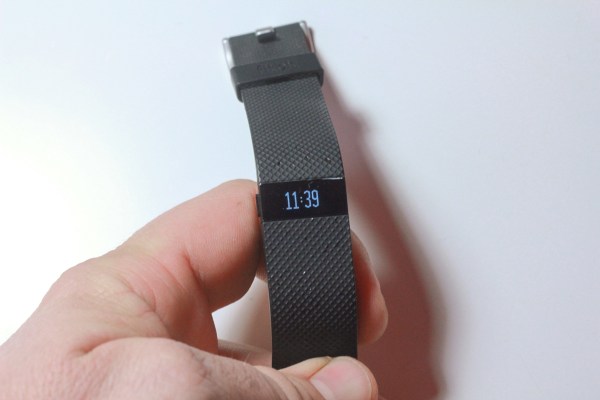As a longtime lover of all things Fitbit, I’ve missed the good old days. The bright, readable displays and the little tidbits like a slowly growing flower to indicate progress were a real joy back in 2008 when the company launched onstage at Disrupt. Now, seven years later, after multiple styles and sizes, after the launch of the diminutive Flex and the odd Zip, we come to the Charge HR.
The Charge HR is a heart-rate sensing wearable that looks, when deactivated, like a rubber bracelet. To use it you simply wear it on either wrist and go about your day. It senses motion, flights climbed, and your heart rate using an optical sensor. While none of the sensors are as accurate as, say, a chest strap or GPS, the band definitely keeps you apprised of what is going on with your body during the day. It has a battery which lasts about 4 days in my experience – 5 days max – and is about the size of a standard bracelet.
Fitbits aren’t designed for hard-core athletes. They’re essentially a tool for reminding you that you need to move around more and keeping you aware of your sleep patterns. I would honestly not recommend the Fitbit Charge as a runner’s only wearable and would instead say a GPS watch along with the running tally a Charge offers is a superior experience. The Charge is a tool for to get sedentary folks moving and for energetic folks to keep track of how much they moved.
So how does this perform? As a day-to-day device it’s excellent. I prefer it over the Flex and I’ve always preferred Fitbit’s offerings over other devices like the Jawbone Up and the Nike Fuelband. The screen is easy to read, the device itself is light and comfortable, and the heart rate data, while not medical-grade, is just what I was looking for in a wearable. I use my Fitbit as a sort of prod. If I’m under 10,000 steps or I find my heart rate going up due to stress I try to fix the situations. I wear it while exercising but I primarily use a GPS/chest strap runners watch at that time simply because it offers more data at a glance. However, I wear the Fitbit all day every day and notice when it is missing.
Again, who is this for? It’s honestly for anyone who wants to get up and exercise a little more. The big bright screen is a constant admonishment that you could use a break and it’s great to feel the little motor inside the wearable go off when you hit your goal. Think of it as a tiny life coach that lives on your wrist.
Keep in mind the Charge doesn’t handle treadmills consistently. I usually keep mine in my pocket when I’m on my treadmill desk and that tends to keep things nicely counted. However, running on the treadmill usually works just fine.
At $149 the Fitbit Charge is about the same price as similar wearables but I find it to be superior. I’ve had some sort of Fitbit on my bloated, disgusting person for years now and I’ve never been disappointed. My concern? Adding features like Caller ID and advanced notifications will wear down the battery and reduce the usability. I’ve turned those off. However, as a little friend to keep you moving the Fitbit Charge HR works well, is accurate, and very usable.
[gallery ids="1118587,1118591,1118590,1118589,1118588"]
